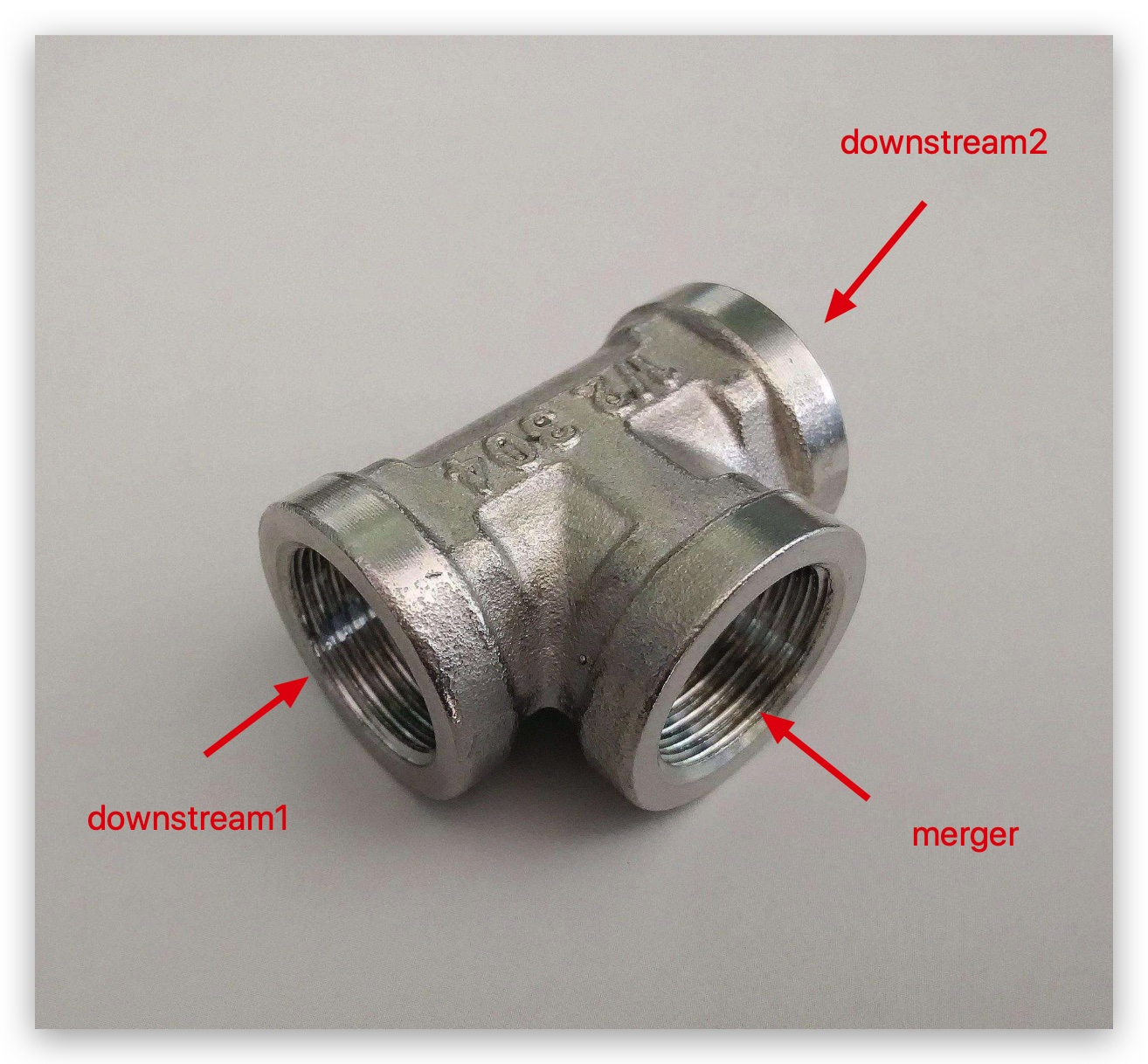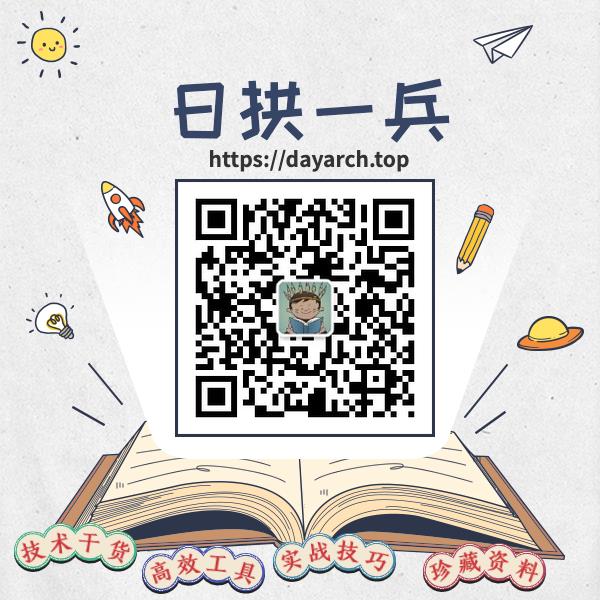前言
在 Java 12 里面有个非常好用但在官方 JEP 没有公布的功能,因为它只是 Collector 中的一个小改动,它的作用是 merge 两个 collector 的结果,这句话显得很抽象,老规矩,我们先来看个图:

管道改造经常会用这个小东西,通常我们叫它「三通」,它的主要作用就是将 downstream1 和 downstream2 的流入合并,然后从 merger 流出
有了这个形象的说明我们就进入正题吧
Collectors.teeing
上面提到的小功能就是 Collectors.teeing API, 先来看一下 JDK 关于该 API 的说明,看着觉得难受的直接忽略,继续向下看例子就好了:
/**
* Returns a {@code Collector} that is a composite of two downstream collectors.
* Every element passed to the resulting collector is processed by both downstream
* collectors, then their results are merged using the specified merge function
* into the final result.
*
* <p>The resulting collector functions do the following:
*
* <ul>
* <li>supplier: creates a result container that contains result containers
* obtained by calling each collector\'s supplier
* <li>accumulator: calls each collector\'s accumulator with its result container
* and the input element
* <li>combiner: calls each collector\'s combiner with two result containers
* <li>finisher: calls each collector\'s finisher with its result container,
* then calls the supplied merger and returns its result.
* </ul>
*
* <p>The resulting collector is {@link Collector.Characteristics#UNORDERED} if both downstream
* collectors are unordered and {@link Collector.Characteristics#CONCURRENT} if both downstream
* collectors are concurrent.
*
* @param <T> the type of the input elements
* @param <R1> the result type of the first collector
* @param <R2> the result type of the second collector
* @param <R> the final result type
* @param downstream1 the first downstream collector
* @param downstream2 the second downstream collector
* @param merger the function which merges two results into the single one
* @return a {@code Collector} which aggregates the results of two supplied collectors.
* @since 12
*/
public static <T, R1, R2, R>
Collector<T, ?, R> teeing(Collector<? super T, ?, R1> downstream1,
Collector<? super T, ?, R2> downstream2,
BiFunction<? super R1, ? super R2, R> merger) {
return teeing0(downstream1, downstream2, merger);
}
API 描述重的一句话非常关键:
Every element passed to the resulting collector is processed by both downstream collectors
结合「三通图」来说明就是,集合中每一个要被传入 merger 的元素都会经过 downstream1 和 downstream2 的加工处理
其中 merger 类型是 BiFunction,也就是说接收两个参数,并输出一个值,请看它的 apply 方法
@FunctionalInterface
public interface BiFunction<T, U, R> {
/**
* Applies this function to the given arguments.
*
* @param t the first function argument
* @param u the second function argument
* @return the function result
*/
R apply(T t, U u);
}
至于可以如何处理,我们来看一些例子吧
例子
为了更好的说明 teeing 的使用,列举了四个例子,看过这四个例子再回看上面的 API 说明,相信你会柳暗花明了
计数和累加
先来看一个经典的问题,给定的数字集合,需要映射整数流中的元素数量和它们的和
class CountSum {
private final Long count;
private final Integer sum;
public CountSum(Long count, Integer sum) {
this.count = count;
this.sum = sum;
}
@Override
public String toString() {
return "CountSum{" +
"count=" + count +
", sum=" + sum +
\'}\';
}
}
通过 Collectors.teeing 处理
CountSum countsum = Stream.of(2, 11, 1, 5, 7, 8, 12)
.collect(Collectors.teeing(
counting(),
summingInt(e -> e),
CountSum::new));
System.out.println(countsum.toString());
- downstream1 通过 Collectors 的静态方法 counting 进行集合计数
- downstream2 通过 Collectors 的静态方法 summingInt 进行集合元素值的累加
- merger 通过 CountSum 构造器收集结果
运行结果:
CountSum{count=7, sum=46}
我们通过 teeing 一次性得到我们想要的结果,继续向下看其他例子:
最大值与最小值
通过给定的集合, 一次性计算出集合的最大值与最小值,同样新建一个类 MinMax,并创建构造器用于 merger 收集结果
class MinMax {
private final Integer min;
private final Integer max;
public MinMax(Integer min, Integer max) {
this.min = min;
this.max = max;
}
@Override
public String toString() {
return "MinMax{" +
"min=" + min +
", max=" + max +
\'}\';
}
}
通过 teeing API 计算结果:
MinMax minmax = Stream.of(2, 11, 1, 5, 7, 8, 12)
.collect(Collectors.teeing(
minBy(Comparator.naturalOrder()),
maxBy(Comparator.naturalOrder()),
(Optional<Integer> a, Optional<Integer> b) -> new MinMax(a.orElse(Integer.MIN_VALUE), b.orElse(Integer.MAX_VALUE))));
System.out.println(minmax.toString());
- downstream1 通过 Collectors 的静态方法 minBy,通过 Comparator 比较器按照自然排序找到最小值
- downstream2 通过 Collectors 的静态方法 maxBy,通过 Comparator 比较器按照自然排序找到最大值
- merger 通过 MinMax 构造器收集结果,只不过为了应对 NPE,将 BiFunction 的两个入参经过 Optional 处理
运行结果:
MinMax{min=1, max=12}
为了验证一下 Optional,我们将集合中添加一个 null 元素,并修改一下排序规则来看一下排序结果:
MinMax minmax = Stream.of(null, 2, 11, 1, 5, 7, 8, 12)
.collect(Collectors.teeing(
minBy(Comparator.nullsFirst(Comparator.naturalOrder())),
maxBy(Comparator.nullsLast(Comparator.naturalOrder())),
(Optional<Integer> a, Optional<Integer> b) -> new MinMax(a.orElse(Integer.MIN_VALUE), b.orElse(Integer.MAX_VALUE))));
- downstream1 处理规则是将 null 放在排序的最前面
- downstream2 处理规则是将 null 放在排序的最后面
- merger 处理时,都会执行 optional.orElse 方法,分别输出最小值与最大值
运行结果:
MinMax{min=-2147483648, max=2147483647}
瓜的总重和单个重量
接下来举一个更贴合实际的操作对象的例子
// 定义瓜的类型和重量
class Melon {
private final String type;
private final int weight;
public Melon(String type, int weight) {
this.type = type;
this.weight = weight;
}
public String getType() {
return type;
}
public int getWeight() {
return weight;
}
}
// 总重和单个重量列表
class WeightsAndTotal {
private final int totalWeight;
private final List<Integer> weights;
public WeightsAndTotal(int totalWeight, List<Integer> weights) {
this.totalWeight = totalWeight;
this.weights = weights;
}
@Override
public String toString() {
return "WeightsAndTotal{" +
"totalWeight=" + totalWeight +
", weights=" + weights +
\'}\';
}
}
通过 teeing API 计算总重量和单个列表重量
List<Melon> melons = Arrays.asList(new Melon("Crenshaw", 1200),
new Melon("Gac", 3000), new Melon("Hemi", 2600),
new Melon("Hemi", 1600), new Melon("Gac", 1200),
new Melon("Apollo", 2600), new Melon("Horned", 1700),
new Melon("Gac", 3000), new Melon("Hemi", 2600)
);
WeightsAndTotal weightsAndTotal = melons.stream()
.collect(Collectors.teeing(
summingInt(Melon::getWeight),
mapping(m -> m.getWeight(), toList()),
WeightsAndTotal::new));
System.out.println(weightsAndTotal.toString());
- downstream1 通过 Collectors 的静态方法 summingInt 做重量累加
- downstream2 通过 Collectors 的静态方法 mapping 提取出瓜的重量,并通过流的终结操作 toList() 获取结果
- merger 通过 WeightsAndTotal 构造器获取结果
运行结果:
WeightsAndTotal{totalWeight=19500, weights=[1200, 3000, 2600, 1600, 1200, 2600, 1700, 3000, 2600]}
继续一个更贴合实际的例子吧:
预约人员列表和预约人数
class Guest {
private String name;
private boolean participating;
private Integer participantsNumber;
public Guest(String name, boolean participating, Integer participantsNumber) {
this.name = name;
this.participating = participating;
this.participantsNumber = participantsNumber;
}
public boolean isParticipating() {
return participating;
}
public Integer getParticipantsNumber() {
return participantsNumber;
}
public String getName() {
return name;
}
}
class EventParticipation {
private List<String> guestNameList;
private Integer totalNumberOfParticipants;
public EventParticipation(List<String> guestNameList, Integer totalNumberOfParticipants) {
this.guestNameList = guestNameList;
this.totalNumberOfParticipants = totalNumberOfParticipants;
}
@Override
public String toString() {
return "EventParticipation { " +
"guests = " + guestNameList +
", total number of participants = " + totalNumberOfParticipants +
" }";
}
}
通过 teeing API 处理
var result = Stream.of(
new Guest("Marco", true, 3),
new Guest("David", false, 2),
new Guest("Roger",true, 6))
.collect(Collectors.teeing(
Collectors.filtering(Guest::isParticipating, Collectors.mapping(Guest::getName, Collectors.toList())),
Collectors.summingInt(Guest::getParticipantsNumber),
EventParticipation::new
));
System.out.println(result);
- downstream1 通过 filtering 方法过滤出确定参加的人,并 mapping 出他们的姓名,最终放到 toList 集合中
- downstream2 通过 summingInt 方法计数累加
- merger 通过 EventParticipation 构造器收集结果
其中我们定义了 var result 来收集结果,并没有指定类型,这个语法糖也加速了我们编程的效率
运行结果:
EventParticipation { guests = [Marco, Roger], total number of participants = 11 }
总结
其实 teeing API 就是灵活应用 Collectors 里面定义的静态方法,将集合元素通过 downstream1 和 downstream2 进行处理,最终通过 merger 收集起来,当项目中有同时获取两个收集结果时,是时候应用我们的 teeing API 了
灵魂追问
- Collectors 里面的静态方法你应用的熟练吗?
- 项目中你们在用 JDK 的版本是多少?
- Lambda 的使用熟练吗?
- 你的灯还亮着吗?

欢迎持续关注公众号:「日拱一兵」
- 前沿 Java 技术干货分享
- 高效工具汇总 | 回复「工具」
- 面试问题分析与解答
- 技术资料领取 | 回复「资料」
以读侦探小说思维轻松趣味学习 Java 技术栈相关知识,本着将复杂问题简单化,抽象问题具体化和图形化原则逐步分解技术问题,技术持续更新,请持续关注......
